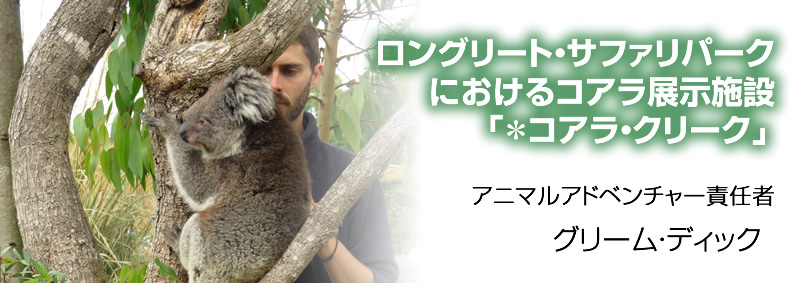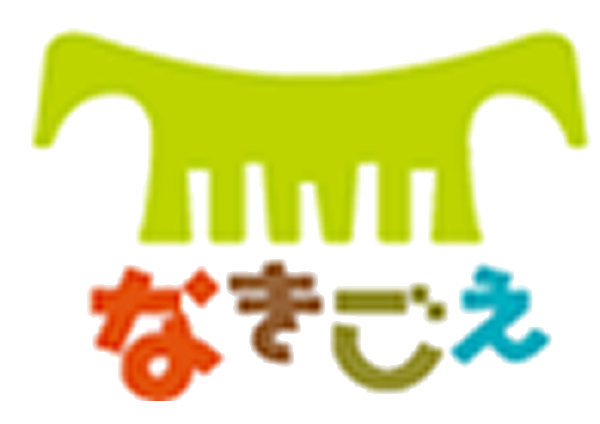

§なぜコアラがロングリート・サファリパークにやって来たのでしょう?
2018年7月に南オーストラリア州政府とロングリート・サファリパークは、コアラとウオンバットを教育と保全を目的とした国際親善大使として、クルランド野生動物公園から移送することに合意しました。
ロングリート・サファリパークは、アデレードを本拠とする国際コアラ研究中核拠点計画(International Koala Centre of Excellence :IKCE)のヨーロッパ拠点となることになっています。IKCEは、コアラの管理と保全を推進するための南オーストラリア州政府による取り組みで、オーストラリアで最も愛されている種が将来にわたって野生で暮らしていけるよう資金を確保し、革新的な調査研究や保全を進めることになっています。
2019年10月に、1頭の雄のコアラが繁殖のための提携に基づいて、大阪の天王寺動物園からロングリート・サファリパークに仲間入りしました。日本ではアークという名前で親しまれていましたが、大阪で最後のコアラとなり、まだまだ繁殖能力のある個体だったため、ロングリート・サファリパークの繁殖計画に加わりました。天王寺動物園の飼育員や獣医師が厳格な視察を行った後に、バーク(アーク)は特別製の輸送箱を用いて飛行機で運ばれ、ヒースロー空港でロングリート・サファリパークの飼育員に受け取られました。新しい我が家にすっかり慣れて、うまくいけばこの夏に同居する雌のコアラに対して鳴き声を掛けています。

ロングリート・サファリパークのコアラ担当者と
天王寺動物園の職員(右から2人目が筆者)

検疫中のアーク
§コアラの何が特別なのか~ロングリート・サファリパークならではのことと、一般的なこと
コアラは、とても珍しい特徴を持っており、見た目にも目立つ動物です。木登りのための二本の親指や、いうまでもなく子育てのための袋を持っていること、ユーカリしか食べないことなど独特の適応を遂げている点、大きな耳、外見的な魅力により、オーストラリアのみならず世界的に見ても象徴的な動物の一種です。
人による影響、泌尿器系の疾病、生息地への打撃など、コアラを保全するためには取り組まなければならないことは非常に多くあります。
コアラは主に2タイプに分類されています。小型の北方系と、より体毛が密で北方系の倍近くの体重になる南方系です。
ロングリート・サファリパークのコアラ・クリークは、イングランドでコアラを見ることができる唯一の施設であり、さらにイギリスでコアラを飼育している2施設のうちの1つで、さらにはヨーロッパで南方系コアラを飼育しているただ1つの施設です。

ロングリート・サファリパークのコアラ舎
野生のコアラは、国際自然保護連合(IUCN)のレッドリストで絶滅危惧II類に指定されています。 2012年に、コアラはオーストラリアの法律により「絶滅の危機にある動物」に指定されました。
ヨーロッパで唯一南方系コアラを飼育していることから、私たちはこのタイプのコアラの調査研究拠点および繁殖センターとして活動しています。コアラは、教育的な価値が高く、国が定めた教育カリキュラムにも関連しているため、私たちが学校を対象として立ち上げた教育プログラムにも貢献してくれています。
§ロングリート・サファリパークのコアラについての背景~何を得たか、どのような生活環境か
ロングリート・サファリパークでは、デニスとバーク(アーク)と呼ばれる2頭の雄を含む南方系コアラの集団、エリーと呼ばれる1頭のミナミケバナウォンバットおよび小型のカンガルーのような有袋類であるハナナガネズミカンガルーの家族を飼育しています。
これらの動物は、自然の小川やユーカリの木、止まり木、自然をあしらった屋内外の放飼場、観覧エリア、解説パネル、コアラ治療室を備えた、専用施設であるコアラ・クリークで暮らしています。
現在、ロングリート・サファリパークでは毎週1回ユーカリを入荷していますが、それ以外にも4000本のユーカリの栽培地を作るとともに植栽管理者を常勤で雇用したため、コアラの主食の供給に非常に役立つだろうと考えています。
§重要な保全メッセージとは
コアラは、人間の影響、クラミジアや腎不全などの病気、および最近IUCNによって特定された気候変動への影響を受けやすいことなど、非常に脆弱な種です。ロングリート・サファリパークの重要な役割の1つは、動物園にやってくる来園者の教育と啓発を行うとともに、コアラの保護活動に世界的に挑戦する知識の格差に取り組むための革新的で戦略的な科学研究を促進することです。
南オーストラリア州政府は、独立した研究機関である国際コアラ研究中核拠点(IKCE)を設立し、パートナーシップを結び、コアラの理解と保護に関する重要な研究と効率の良い方法に関する科学を推進しています。
ロングリート・サファリパークは、ノッティンガム大学のコアラ・レトロウイルス・プロジェクトなど、さまざまなパートナーと緊密に連携しています。 ロングリート・サファリパークのコアラから提供される医療データは、レトロウイルスと遺伝子配列決定に関する画期的な研究に直接入力されるだけでなく、行動、食事、健康管理に関する進行中の新しい研究の将来の機会を提供します。
§コアラは野生で危険にさらされていますか?もしそうなら、なぜでしょうか?
オーストラリアの東部州では、コアラはオーストラリア政府の中心的な環境法である、1999年環境保護および生物多様性保全法(EPBC法)の下で絶滅危惧種とされています。オーストラリア南部ではコアラの数が増えており、この地域には世界で最も重要なコアラの個体数が残っている可能性があります。 ただし、個体数が多くても必ずしも種へのリスクが少ないとは限りません。 一部の地域のコアラの密度が高いと生息地が破壊され、コアラや同じ生息地に依存している他の種が危険にさらされます。
§主な脅威は何でしょうか?
病気、気候変動、生息地の喪失、過密状態および飢餓は依然として本当のリスクです。 コアラは都市部に移動する際にも危険にさらされます。交通事故にあったり、犬に襲われたり、プールに落ちる可能性もあります。
§どのような種類の研究を実施/参加したいと考えているのでしょうか?
IKCEは、3つの異なる分野の研究をサポートしています。
・風景の中のコアラ
・コアラの健康と幸福
・コミュニティのコアラ
ロングリート・サファリパークは、これらすべての研究目標をサポートするとともに、コアラの行動、栄養、ユーカリ管理、コアラの疾病のリスクを研究しようとしている地域の科学機関と協力しています。
§科学的な観点からコアラについてほとんど知られていないのはなぜでしょうか?
コアラは1日に最大18時間眠るので、野生での行動を観察することが困難です。 したがって、微妙な動作の違いを検出して文書化することは困難です。これに加えて、過去のオーストラリアではコアラが乱獲され、野生の遺伝子の多様性が失われ、コアラが直面してい急性疾患の問題に影響を与えている可能性があります。膨大な研究が、野生の行動と食習慣だけでなく、遺伝学と個体群を持続的に管理する方法についても行われています。
§ロングリート・サファリパークのコアラからの将来への希望は何でしょうか?
コアラは世界中で愛されています。 オーストラリアの大使として、彼らはオーストラリアの在来動物の重要性と独自性、および英国での保護に関するメッセージを伝え、広めることができます。
ロングリート・サファリパークのグループは、オーストラリア以外で国際的な繁殖プログラムを開始し、研究、教育、強力なバイオセキュアな血統のための重要なリソースを形成していきたいと考えています。

昨年の12月15日アークの誕生日にユーカリケーキをプレゼント
*編集部注:「コアラ・クリーク」はロングリート・サファリパーク内で、コアラを中心にオーストラリアの動物達を展示しているエリアの施設名称
KOALA CREEK – LONGLEAT
Why have koalas come to Longleat?
In July 2018 the South Australian Government signed an MOU with Longleat, agreeing to transfer koalas and wombats from Cleland Wildlife Park to act as international ambassador animals for education and conservation purposes.
Longleat will be a European hub for the International Koala Centre of Excellence (ICKE), based in Adelaide. ICKE is an initiative by the Government of South Australia to enhance the management and conservation of koala. It will fund and direct ground-breaking research and conservation of Australia’s best loved species in the hope of securing its long term future in the wild.
In October 2019 a single male Koala joined Longleat under a breeding partnership with Osaka Tennoji Zoo in Japan. Ark as he was known in Japan, joined the Longleat breeding program as he was the last of the koalas in Osaka and still a viable breeding individual. After a rigorous inspection from the Osaka zoo keepers and curators, Burke (Ark) was flown over in a specially made crate and hand collected at heathrow airport by the Longleat koala keepers. He is settling into his new home very well and already bellowing at the female koalas who he will hopefully meet in the summer.
What makes them so special – The ones at Longleat and in general
Koalas are an incredibly unique and visually striking animal. They are one of the most iconic animals in Austalia and throughout the world for their appealing appearence, large ears and unique adapatations – such as double thumbs for climbing, specialist diet of eucalyptus and of course pouch for rearing young.
There is also a huge conservation requirement for them with human impact, oxalate nephrosis and impact on habitat being massive challenges to address.
There are two main subspecies of koala; the smaller northern variety and the Southern which has much thicker fur and can weigh twice as much as their northern relatives.
Longleat’s Koala Creek will be the only place to see koalas in England, one of only two locations in the UK, and the only the location in Europe to look after Southern Koalas Phascolarctos cinereus victor.
Koalas are officially considered to be vulnerable in the wild according to the International Union for Conservation of Nature Red List of Threatened Species.
In 2012 the koala was listed as 'vulnerable to extinction' under Australian Law.
These are the only southern koalas in Europe and we will act as a research hub focus for this sub species as well as breeding centre for their subspecies.
They have a huge educational value and links to the national curriculum – Which works well into our established school programme.
Background on the koalas at Longleat – What have we got and what is there living environment like.
Longleat is home to a group of southern koalas, including two males called Dennis and a Burke (Ark), along with a southern hairy-nosed wombats, Lasiorhinus latifrons. Ellie and a family of potoroos Potorous tridactylus miniature kangaroo-like marsupials.
They live in the purpose-built Koala Creek facility which includes a natural stream, eucalyptus trees, climbing poles, naturally-themed indoor and outdoor habitats, viewing areas, interpretation boards as well as a Koala Care unit.
Longleat currently has weekly deliveries of eucalyptus plants delivered to the park but also have developed a 4,000-tree eucalyptus plantation and employed a full-time browse manager that will ultimately help provide the main source of food for the koalas
What are key conservation messages
Koalas are an incredibly vulnerable species susceptible to hiuman impact, diseases such as chlamydia and kidney failure as well as the effects on climate change as identified recently by the IUCN. One of Longleat’s key roles will be to educate and raise awareness to visitors coming o the park as well as help facilitate innovative, strategic scientific research to address the knowledge gaps that challenge koala conservation efforts globally.
The South Australian Government established the IKCE (International Koala Centre of Excellence), an independent research organisation, to work in partnership, facilitating vital research and best practice science into our understanding and conservation of koalas.
Longleat work closely with a variety of partners including the University of Nottingham’s koala retrovirus project. Medical data supplied from the koalas at Longleat will directly input into groundbreaking research on retrovirus and geno sequencing as well as offering future opportunities for ongoing and new studies into behaviour, diet and healthcare.
Are koalas at risk in the wild and if so why?
In the eastern states of Australia, koalas are listed as vulnerable to a threat of extinction under the Environment Protection and Biodiversity Conservation Act 1999 (the EPBC Act), the Australian Government’s central piece of environmental legislation.
There are higher numbers of koalas across southern Australia, and this region may potentially have the last of the world’s significant koala populations. However, greater numbers don’t necessarily mean fewer risks to the species. High densities of koalas in some areas cause destruction of habitat and this puts koalas, and other species relying on the same habitat, at risk.
What are the main threats?
Disease, climate change, loss of habitat and overcrowding and starvation remain real risks. Koalas are also threatened as they move into urban areas, where they are struck by cars, attacked by dogs and can fall into swimming pools.
What type of research are we hoping to conduct/ be involved in?
The IKCE is supporting research into three different areas:
Koalas in the landscape
Koala health and wellbeing
Koalas in the community.
Longleat is supporting all of these research goals as well as providing access for regional scientific institutions looking to study koala behaviour, nutrition, eucalyptus management and koala disease risks.
Why is so little known about koalas from a scientific point of view?
Koalas can sleep for up to 18 hours a day which results in increased difficulties monitoring wild behaviours. Therefore subtle behaviour differences are hard to detect and document.
Added to this over hunting in the past in Austrlia has resulted in a lower wild gentic pool, which could be the main influences to the rapid disease issues facing koalas.
A huge volume of work is being undertaken not only on their wild behaviour and feeding habits but also on their genetics and ways of managing their populations sustainably.
What are our hopes for the future from the koalas at Longleat?
Koalas are much loved around the world. As Australian ambassador animals, they are able to educate and spread the message about the importance and uniqueness of Australian native animals and their conservation in the United Kingdom.
The hope is that the group at Longleat will form the start of an international breeding programme outside of Australia forming a key resource for research, education and strong bio secure bloodline.

